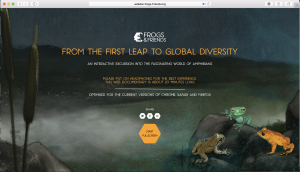Admittedly, I was under the impression that there were no classes in Week 5 for all modules so I did not attend the tutorial. As expected, I have some notes to refer to as well as my answers to the group who presented that week.
Let’s begin.
The topic this week covered Interactive and Immersive Narratives. This is an exciting topic for me, as it presents a world of many possibilities. As I’ve begun shape-forming my own idea to pitch to the class and submit a proposal, and the idea of immersive storytelling and interactivity conjures up a dark starry night, the sound of waves and a ship that sails across with a narrator’s voice over the top which encourages the user end to consider the perspective of a merchant from X, Y or Z era- which would they be? They select one. Then, depending on the which they select they get to choose the kind of commodity they want that was linked to Holland, Portugal or Britain. Then they are transported back in time and are presented with a media matrix of possibility- from online articles and photography to short videos and podcasts, the user gets to learn what the particular trail of this merchant influenced the making of a minority community come to be known as the Anglo-Indians.
Going through the modules we read that I-Doc’s Judith Arthur describes Interactive Narratives as an expression of many possibilities in terms of the way the user end connects to a story- be it tapping an i-Pad or tablet, clicking a mouse, scanning a QR codes, etc. (i-Docs, nd) So here, we are talking about the way a person may navigate a narrative from a technical point of view. Immersive Narrative, on the other hand, is referred to as a technique of storytelling which is making its way into spaces such as galleries, games, theatres, journalism, and advertising.
An example of an Interactive Narrative I can think of first hand is ScreenWorlds at ACMI. The space is a “journey through time” chronologically curated gallery, exploring the history of the “moving image” and sound. The gallery includes magic lanterns, buttons, touch screens and retro game consoles. So, there are a number of actions a visitor can take.
In terms of Immersive Narratives, the first example that comes to mind is a downloadable podcast tour, created to be listened to while strolling through Boyd Park in Murrumbeena. Here, the project makes use of a true-to-life environment while narrating a tour. Much like a traditional tour, the attendee is gaining an immersive experience via a technique of storytelling.
There was an interesting question provided by the presenters for this particular week which asked whether classmates preferred games created with an emphasis on storytelling (in its study form referred to as narratology) or games with goals, rules, and gameplay (in its study form referred to as ludology). My initial answer to that question was storytelling but upon further consideration, I’ve always enjoyed a combination of the two in games such as the Super Mario Brothers series, Zelda and Mortal Combat. That magical amalgamation of characters and stories with the excitement of character can’t be beaten.
Considering the questions regarding VR, I can see it being popularised slowly but surely in the future. It’s already gained momentum thanks to Samsung and museum galleries like Triennial at NGV. The industries I predict it will be popular in include museums and galleries, gaming, and education. Museums and galleries because they have a presence in these areas and have been well received, gaming because advancements in interactive technology are generally received enthusiastically (Wii games for example) and education because I’ve already seen online tools and 3D animation being used in industrial training, so why not VR?
Limitations involve costs and considering why VR is valuable as a medium for a project- what does the user end take away from the experience other than the new technology itself?
Reference
Aston, Judith nd, ‘Interactive documentary – what does it mean and why does it matter?’ , www.i-Docs.org , viewed 14 April 2018, <http://i-docs.org/2016/03/27/interactive-documentary-what-does-it-mean-and-why-does-it-matter/>


